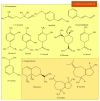Essential Oils and Their Major Compounds in the Treatment of Chronic Inflammation: A Review of Antioxidant Potential in Preclinical Studies and Molecular Mechanisms
- PMID: 30671173
- PMCID: PMC6323437
- DOI: 10.1155/2018/6468593
Essential Oils and Their Major Compounds in the Treatment of Chronic Inflammation: A Review of Antioxidant Potential in Preclinical Studies and Molecular Mechanisms
Abstract
Inflammatory diseases result from the body's response to tissue damage, and if the resolution is not adequate or the stimulus persists, there will be progression from acute inflammation to chronic inflammation, leading to the development of cancer and neurodegenerative and autoimmune diseases. Due to the complexity of events that occur in inflammation associated with the adverse effects of drugs used in clinical practice, it is necessary to search for new biologically active compounds with anti-inflammatory activity. Among natural products, essential oils (EOs) present promising results in preclinical studies, with action in the main mechanisms involved in the pathology of inflammation. The present systematic review summarizes the pharmacological effects of EOs and their compounds in in vitro and in vivo models for inflammation. The research was conducted in the following databases: PubMed, Scopus, BIREME, Scielo, Open Grey, and Science Direct. Based on the inclusion criteria, 30 articles were selected and discussed in this review. The studies listed revealed a potential activity of EOs and their compounds for the treatment of inflammatory diseases, especially in chronic inflammatory conditions, with the main mechanism involving reduction of reactive oxygen and nitrogen species associated with an elevation of antioxidant enzymes as well as the reduction of the nuclear factor kappa B (NF-κB), reducing the expression of proinflammatory cytokines. Thus, this review suggests that EOs and their major compounds are promising tools for the treatment of chronic inflammation.
Figures






References
-
- Ahmed M. E., Khan M. M., Javed H., et al. Amelioration of cognitive impairment and neurodegeneration by catechin hydrate in rat model of streptozotocin-induced experimental dementia of Alzheimer’s type. Neurochemistry International. 2013;62(4):492–501. doi: 10.1016/j.neuint.2013.02.006. - DOI - PubMed
Publication types
MeSH terms
Substances
LinkOut - more resources
Full Text Sources
Medical

